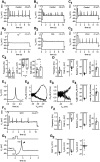T-Type Ca2+ Channels Boost Neurotransmission in Mammalian Cone Photoreceptors
- PMID: 35803735
- PMCID: PMC9398539
- DOI: 10.1523/JNEUROSCI.1878-21.2022
T-Type Ca2+ Channels Boost Neurotransmission in Mammalian Cone Photoreceptors
Abstract
It is a commonly accepted view that light stimulation of mammalian photoreceptors causes a graded change in membrane potential instead of developing a spike. The presynaptic Ca2+ channels serve as a crucial link for the coding of membrane potential variations into neurotransmitter release. Cav1.4 L-type Ca2+ channels are expressed in photoreceptor terminals, but the complete pool of Ca2+ channels in cone photoreceptors appears to be more diverse. Here, we discovered, employing whole-cell patch-clamp recording from cone photoreceptor terminals in both sexes of mice, that their Ca2+ currents are composed of low- (T-type Ca2+ channels) and high- (L-type Ca2+ channels) voltage-activated components. Furthermore, Ca2+ channels exerted self-generated spike behavior in dark membrane potentials, and spikes were generated in response to light/dark transition. The application of fast and slow Ca2+ chelators revealed that T-type Ca2+ channels are located close to the release machinery. Furthermore, capacitance measurements indicated that they are involved in evoked vesicle release. Additionally, RT-PCR experiments showed the presence of Cav3.2 T-type Ca2+ channels in cone photoreceptors but not in rod photoreceptors. Altogether, we found several crucial functions of T-type Ca2+ channels, which increase the functional repertoire of cone photoreceptors. Namely, they extend cone photoreceptor light-responsive membrane potential range, amplify dark responses, generate spikes, increase intracellular Ca2+ levels, and boost synaptic transmission.SIGNIFICANCE STATEMENT Photoreceptors provide the first synapse for coding light information. The key elements in synaptic transmission are the voltage-sensitive Ca2+ channels. Here, we provide evidence that mouse cone photoreceptors express low-voltage-activated Cav3.2 T-type Ca2+ channels in addition to high-voltage-activated L-type Ca2+ channels. The presence of T-type Ca2+ channels in cone photoreceptors appears to extend their light-responsive membrane potential range, amplify dark response, generate spikes, increase intracellular Ca2+ levels, and boost synaptic transmission. By these functions, Cav3.2 T-type Ca2+ channels increase the functional repertoire of cone photoreceptors.
Keywords: Cav3.2; calcium; cone photoreceptors; exocytosis; spike.
Copyright © 2022 the authors.
Figures








References
-
- Babai N, Gierke K, Müller T, Regus-Leidig H, Brandstätter JH, Feigenspan A (2019) Signal transmission at invaginating cone photoreceptor synaptic contacts following deletion of the presynaptic cytomatrix protein Bassoon in mouse retina. Acta Physiol (Oxf) 226:e13241. 10.1111/apha.13241 - DOI - PubMed
Publication types
MeSH terms
Substances
LinkOut - more resources
Full Text Sources
Molecular Biology Databases
Miscellaneous
